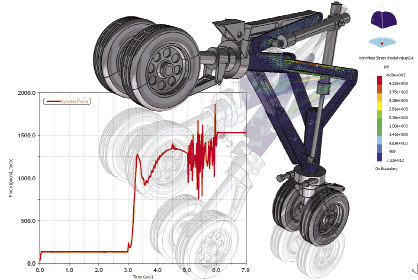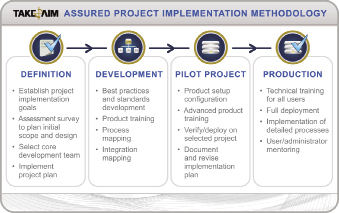Latest News
July 1, 2013
 Simulation of a nose landing gear to check the durability is a typical service analysis that could be provided by MSC Software. |
When everything goes the way it should, it is a win-win for each party. When things go wrong, well, that’s another story. In fact, this is that story, from the service provider’s perspective. A few “mistakes to avoid” were commonly found in discussions DE recently had with four service providers.
Mistake No. 1: Starting Sans Plan
When a company has provided services to numerous customers and has been in business for several decades, it seems reasonable to expect that its team has a very good idea of what should and should not happen when a client engages them. Over its 35-year history, ATA Engineering has had many well-established relationships with long-term clients. They interact in what President and Technical Director Mary Baker, Ph.D., P.E., calls “methods development.”
“People usually come to us because they are challenged by their schedule or because they have a new technical issue,” explains Baker. “They might have had people who did it before, but aren’t with them anymore, or it’s just a new method.”
Working mainly in the aerospace industry on launch vehicles, satellites, Mars rovers and other specialized space vehicles, ATA Engineering frequently helps customers by simulating the dynamic performance to understand the modes so customers can design to required loads, and can demonstrate by analysis or testing that the loading environmental requirements are being met. These functions include anything from random vibration to temperature variations.
In many instances, outsourcing a service is not part of the project—until a problem occurs. “You’re struggling with a problem and you don’t know whether it is worth your time to get someone else to help you or not,” says Baker. “It’s our job to make it easy for you to get our help.”
Frequently, ATA Engineering’s effort is defined by a statement of work that deals with the customer’s challenging issues, including the reluctance to engage an outside service provider. “We often volunteer to write a draft statement that they can edit and change if it doesn’t seem right to them,” says Baker.
Derek Barkey, senior manager of Engineering Services for MSC Software, has 28 years of experience in the service industry. He has a slightly different recommendation for customers to understand the objectives for the engineering service providers. “Sometimes the process of writing a request for quotation helps customers clarify what precisely they want,” he says.
MSC Software started as a services company when it was founded in 1963. Its core software products are oriented around engineering simulation. The company focuses on engineering analysis and the data management around that analysis, performing structural, crash, acoustic and thermal analysis and more. It is frequently subcontracted for one or more of these aspects.
Another engineering service company with a long history is Engineering Technology Associates (ETA). The company is celebrating its 30th year of business. Historically, ETA’s customers have been automotive original equipment manufacturers (OEMs) and Tier I suppliers, but new industries are part of its focus moving forward.
 The key steps in IMAGINiT Technologies’ Take Aim consulting process for engineering service success address four phases with several subcategories. Photo courtesy of IMAGINiT Technologies. |
According to Akbar Farahani, ETA’s vice president of engineering, one of the primary reasons that a customer can encounter problems is failing to plan. A thorough plan should include full discovery, including the project objectives and what they are trying to accomplish—reduce product failures, reduce scrap parts, meet customer requirements, certifications or regulations and all related aspects. In addition to staying focused around the objectives, more successful service engagements occur when the manufacturer dedicates someone to that particular project.
“We see great success when somebody is actually going to be accountable for the project, and they take ownership of the responsibilities in the engagement,” says Farahani.
Many companies, especially automotive companies, want to do less testing and prototype building and more virtual modeling. This area is growing rapidly, according to Farahani.
“Investments in physical tests are declining, while investments in virtual prototyping and simulation are on the increase,” he says.
Any area with rapid growth can easily produce new participants that are not necessarily as well versed as the more established players, and users can easily expect more than what is reasonable. A process developed by ETA deals with the growing demand.
IMAGINiT Technologies, a Division of Rand, works primarily in the CAD/CAM space.
“The software foundation for a lot of the things we do is around the Autodesk solutions, but the services that we offer are not limited to that by any means,” says Bill Zavadil, senior vice president of services for IMAGINiT Technologies. “We’ve worked with customers everywhere from Fortune 500 manufacturers to two- or three-man shops, so we deal with the entire spectrum.”
The experience level of these companies ranges from long-time clients of IMAGINiT Technologies who are evolving new portions of their business, to new clients. Zavadil has a few observations that may help customers to avoid problems.
“It depends on their maturity and how well documented their processes are, and where they are at in their own evolution of trying to standardize their practices and procedures,” he advises.
While the first step is identifying the objectives, many clients fail to understand that successful engagement of service providers involves more than buying software and getting training for implementation.
“The software that is out there today, really does start to impact their business process,” says Zavadil. “If they don’t plan on changing and understanding the impact that it is going to have on their business process, and make plans to make those modifications and hire somebody to help consult with them in terms of what impact it is going to have with workflows and processes, they are going to fail.”
Mistake No. 2: Estimating Capabilities
The problem of overestimating capabilities often occurs with the customer whose limitations of equipment, software tools and in-house engineering expertise are not well known or understood.
In contrast, customers can under- and overestimate the capabilities of suppliers. While most of the time expectations are exceeded, in some cases where their expectations are out of line, then it is difficult or impossible to meet them, explains Laura Abert, ETA’s director of marketing.
Mistakes can be avoided if the supplier is willing to work with the client up front to determine the requirements and understand the responsibilities of both parties to solve the problem. In fact, understanding the proper problem partitioning can prevent numerous pitfalls.
“It’s our job to keep them from having problems,” ATA Engineering’s Baker says.
In addition to clearly defining the problem and what is required to solve it, the portion being performed by each party must be clearly understood. Baker says she often helps the client solve the problem simply by discussing it. While this discussion doesn’t create an invoice, it does usually create a satisfied customer who comes back in the future.
Misunderstanding the statement of work can also cause expectation problems. “The most common problem is that customers haven’t truly read through the written statement of work,” says MSC Software’s Barkey.
A good services statement of work, he adds, will define what deliverables the customer will receive and what their responsibilities are.
In addition to customers not knowing know what to expect, they often do not understand the constraints.
“FEA (finite element analysis) or virtual design is not going to invent,” says ETA’s Farahani. “Invention comes from engineers. The tools enable us to get to the answer faster. The most important thing is the interpretation of those results.”
Mistake No. 3: Engaging without a Process
Companies that have experienced bad results may attribute their situation to wrong internal decisions after being provided accurate analysis. Farahani credits a proprietary process that ETA uses for successful customer engagements to helping customers, especially less-experienced customers, understand what to expect.
In a similar vein, IMAGINiT Technologies uses the Take Aim process as an integral part of its consulting.
Establishing a reasonable schedule for completion and milestones to jointly evaluate progress is an essential part of the process, according to MSC Software’s Barkey. He has an associated warning: “Don’t try to micromanage the services provider, but you do have a right to know that your money is being spent well.”
Mistake No. 4: Too Little, Too Late
The biggest mistake a potential user of engineering services can make is never getting started. “Without using a process such as ours, they do not know what they are missing,” says ETA’s Abert.
An equally problematic situation can occur if the supplier is engaged too late—after the customer already has analysis that shows the approach it was developing will not achieve its goals, and it has run out of time. In either case, the advice is similar.
“The first step is to have a conversation about the situation, and then jointly define what would help,” says ATA Engineering’s Baker. “Lots of times, we just point them in a direction that they hadn’t thought of.”
Randy Frank is a contributor to DE. Send e-mail about this article to [email protected].
More info
Subscribe to our FREE magazine, FREE email newsletters or both!
Latest News
About the Author
Randy FrankRandy Frank is a freelance technology writer based in Arizona. Contact him via [email protected].
Follow DE





